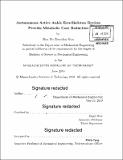Autonomous active ankle exo-skeleton devices provide metabolic cost reduction
Author(s)
Koo, Bon Ho Brandon.
Download1130578072-MIT.pdf (2.504Mb)
Other Contributors
Massachusetts Institute of Technology. Department of Mechanical Engineering.
Advisor
Hugh Herr.
Terms of use
Metadata
Show full item recordAbstract
In this thesis, I designed and conducted an experiment that looks to confirm the metabolic cost decrease associated with the usage of an autonomous active ankle exoskeleton. The primary method to identify the associated metabolic costs was through the comparison of cardiovascular and respiratory activity during gait with and without the use of the exoskeleton. Rates of oxygen consumption, carbon dioxide production, and pulse were recorded for both control and experimental trials. Using these physiological responses, associated energy expenditure rates were calculated. The results of these trials suggest the presence of a quantifiable reduction in energy expenditure rate seen by the implementation of an autonomous active ankle exoskeleton in flat-terrain walking protocols. Additionally, the time to convergence, defined as the time a particular data-set takes to reach steady-state, was calculated using the same physiological responses. The results of this observation suggest that the time to convergence of metabolic indicators is much shorter than previously assumed. Finally, the potential benefits of utilizing a custom exoskeleton interface are quantified and elaborated.
Description
Thesis: S.B., Massachusetts Institute of Technology, Department of Mechanical Engineering, 2019 Cataloged from PDF version of thesis. Includes bibliographical references (pages 35-36).
Date issued
2019Department
Massachusetts Institute of Technology. Department of Mechanical EngineeringPublisher
Massachusetts Institute of Technology
Keywords
Mechanical Engineering.